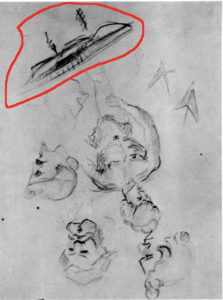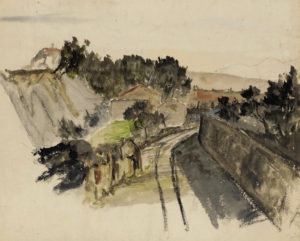R089 La Tranchée 1867-1868 (FWN48)
Pavel Machotka
(Cliquer sur l’image pour l’agrandir)
Toward the end of the 1860s, in the small sketch La Tranchée Cézanne returns momentarily to a style characterized by swirls of thick impasto. The style is natural to the small canvas size and is suggested by the sweeping curve of a railroad track and an interplay of diagonals. However, unlike the site photograph, whose space is deep and sharply recessive, the painting seems both shallow and balanced. The railroad track – the principal diagonal — succeeds in remaining in the canvas plane: it does not curve back to the right and disappear, but leads to a point in the center where it is stopped abruptly by the congested, magnified forms. Cézanne may have stood somewhat to the left of the photographer and seen more of the central hill, but it seems safe to say that he has made sure to magnify it and bring it close to the picture plane. The red ball, which in Cézanne’s pencil sketch (C120)[1] was merely a thin, oblong semaphore, here arrests and focuses our vision.
The color harmony is simple and balanced, and differs from the triad of hues familiar from later Aix landscapes in only one respect. It substitutes a coral-orange for the more common brown-tinted yellow (referred to technically as Naples yellow[2]); otherwise it shares its blues and greens with the other landscapes. The coral-orange is in fact close to the color of the local soil, here uncovered by the cut in the hillside (and overstated by the painter). The small painting betrays a powerful impulse, expressed formally in the clashing diagonals and intense colors, and physically with the thick, undulating, lumpy touch.
Adapted from Pavel Machotka, Cézanne: Landscape into art.
[1] See Adrien Chappuis, The Drawings of Paul Cézanne, 1973.
[2] I shall use the technical name because Cézanne would not have referred to it in any other way. Bernard reports that when he showed Cézanne his own palette, which had only four colors and white on it, Cézanne asked: “You paint only with that?” “Yes.” “Where is your Naples yellow? Where is your peach black, your sienna, your cobalt blue, your burnt crimson lake?” (In Doran, Conversations, p. 61 (French edition), p. 62 (English edition)
NB. On peut voir, comme Chappuis, une première ébauche grossière du paysage dans le dessin C0040g de 1859-1860.
Une aquarelle traite également du thème :
Voir aussi le tableau La Tranchée avec la montagne Sainte-Victoire






